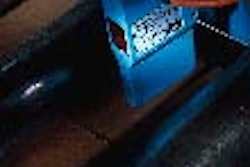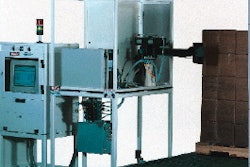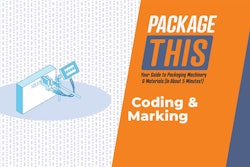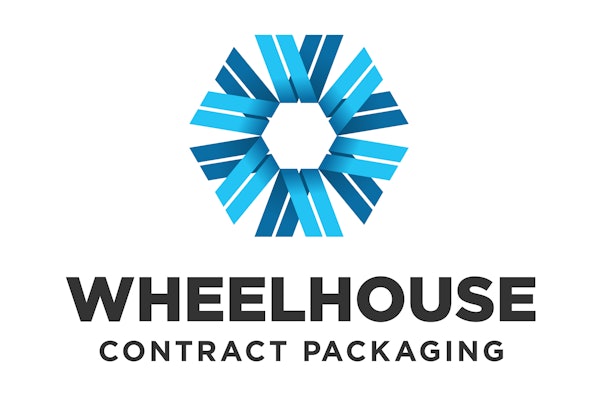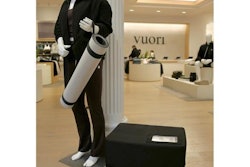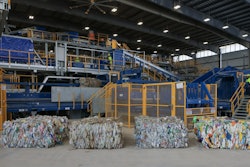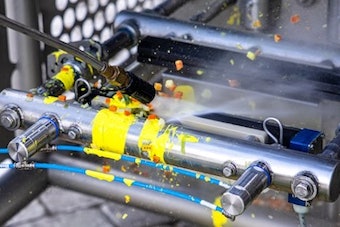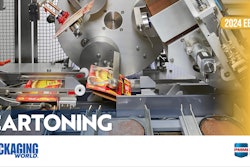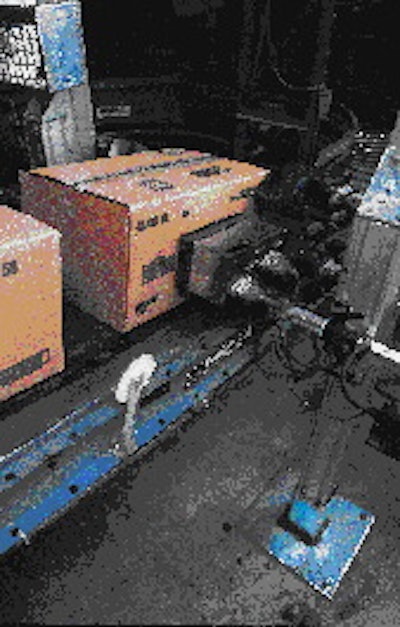
North America's largest pasta company recently completed a $16 million multi-plant installation of on-line case coding equipment that has freed up loads of warehouse space, reduced knocked-down case inventory significantly, and saved thousands of dollars in corrugated costs.
The company is Borden, which is based in Columbus, OH. But the upgrade began in the firm's St. Louis facility, where knocked-down cases used to come from corrugated suppliers with brand logos, product description, case counts, and other information all preprinted. Now that information is printed on line by computer-controlled ink-jet equipment supplied by Marsh Co. (Belleville, IL), so the identical case can be used for a broad range of product types or brands. This makes case ordering so much simpler that knocked-down case inventory in the plant has dropped from 1.8 million preprinted units to 600ꯠ.
In addition to occupying excessive amounts of warehouse space and being more costly than unprinted cases, preprinted corrugated cases were a drag on packaging productivity. Each time one of the 22 packaging lines in the plant had to be changed to a new SKU, plant personnel had to spend an average of 30 minutes locating the preprinted cases-if they were in stock-and loading them into the case packer's magazine. And this in a plant that operates around the clock, seven days/week.
Though this worked for decades, it flies in the face of Efficient Consumer Response, a leading distribution theory of the day that pushes manufacturing and packaging as close to the consumer as possible. Borden management knew a change was in order.
"The paradigm was to run the production lines with whatever corrugated was in stock," says Borden engineering manager Kurt McClellan. "We weren't customer-driven, we were supply-driven."
Borden's product testing and research group identified Marsh as the on-line case-coding vendor of choice because its systems had already been proven in the field. "We wanted something that was an off-the-shelf product at Marsh," says Kim Mitchell, project manager for package development at Borden's research and development center in Syracuse, NY. "Other vendors said, 'We can do this,' while Marsh said 'We already have.'"
Case consolidation
Paving the way to Borden's current on-line case printing capabilities was an ambitious case standardization effort. With assistance from TOPS Eng. Corp. (Plano, TX), Borden optimized its case sizes and pallet configurations. Companywide, it reduced the number of case sizes from 450 to 80. It also consolidated its corrugated purchasing primarily with Stone Container (Chicago, IL) to take advantage of economies of scale.
Since the move away from preprinted cases, the only information printed on a Borden case by its maker is a material specification and a case specification number. Production runs are organized by case size. So many different runs now call for the same case size that a line may run for days without requiring a change in cases. When going from one pasta type or brand to another, the line operator simply scans a bar code and the new information to be printed on the case is quickly downloaded to the on-line print stations. It might take five minutes where it used to take 30 to locate and load preprinted cases.
At the St. Louis plant, now mounted shortly after the case packer discharge on all 22 lines is an ink-jet print station consisting of the following Marsh components:
* two single-head 96-dpi print heads (one on each side),
* two single-head 192-dpi print heads (one on each side),
* two dual-head print heads (one on each side), and
* two print station controllers.
Also installed near each print station on each line is an operator's input station. It's equipped with a VT420 terminal and keyboard as well as a hand-held bar-code scanner and a booklet of bar codes, one for each of the plant's 1걄 SKUs. When it's time to change to a new SKU, the operator can either type in a code at the keyboard or scan the appropriate bar code from the booklet. Within seconds, the new message to be printed appears on the terminal so the operator can view it before downloading it to the print station controllers.
Central controllers
All print station controllers are networked to two central Hi-Res host controllers located at the system administrator's station, located in an office space overlooking the plant floor. Borden uses two of these host controllers to get faster data processing in this large installation than could be achieved with only one controller. Anything an operator can do to the network, like change a print message, can also be done from these host controllers.
Also critical in the system is Marsh's Print Manager software. When operators scan bar codes at the input stations, the software recognizes information contained in the bar code and pulls up everything that must be printed. This information is then sent to the print station for correct case coding. The interactive Print Manager software also takes operators step by step through the process of creating and editing new messages. It also creates activity logs that track how and when the system is being used and who is using it.
At each print station, the 96-dpi print heads are configured to print product count, weight, and human-readable product code on the upper portion of the case. The 192-dpi print heads handle real-time production information and the SCC-14 shipping container bar code (62.5% magnification) with the human-readable text beneath the bar code on the lower portion of the shipping case. Finally, the dual print heads print product logos, graphics, and text in the middle of the side panel.
According to McClellan, most case size changeovers don't even require any repositioning of print heads. In a few cases the operator does have to use hand tools to raise or lower the heads. The fastest packaging line in the plant runs about 14 cases/min, and the print heads are easily up to the task, says McClellan.
On-line scanning
Inches after each shipping case is printed, an Accu-Sort (Telford, PA) bar-code scanner mounted on the Alvey (St. Louis, MO) conveyor frame checks bar-code print quality and triggers an alarm if the code is not readable. The scanner also contributes to operational efficiency.
"By capturing information right after it's printed, it lets the Print Manager software keep constant track of how many cases went through," says Mitchell. "The system administrator can use the information to run production reports, downtime analysis, real-time inventory, and so on. There's lots of potential for this kind of scanning. You can tie it into all kinds of EDI [electronic data interchange] programs."
In the meantime, Borden is enjoying the advantages it's already realized. For example, in 1995, preprinted knocked-down cases occupied more than 40% of the St. Louis warehouse's 176ꯠ sq'. Now, over half of that space has been reclaimed for other purposes.
Another new capability now available to Borden through the Marsh software is computerized tracking of incidents causing downtime. In the past, operators kept a written log of anything causing downtime. Now in the bar- code booklet at each operator input station are bar codes denoting incidents that might cause downtime. If, for example, the case packer jams, the operator records the fact by simply running the hand-held scanner over the bar code in his booklet that denotes "case packer jam." The day's production report is updated instantly back at the host controllers. Not only does it save time for the operator, it eliminates the possibility for misreading an operator's hand-written log.
Better customer service
Of all the benefits gained since on-line case printing went into operation, the most important is that customer service has improved.
"Before, if we didn't have the right packaging available we'd call the corrugated supplier to send it in," says Barb Danville, system administrator. "This took about three days, and we'd miss service opportunities to our customers. Now, we just scan the bar code and it's done."
Adds McClellan: "We can run any product at any time, because we don't have the limitation of being tied to a specific piece of packaging material. The plant produces what the demand dictates."
St. Louis isn't the only site for in-line case printing. Borden now has implemented similar Marsh systems in six plants across the country, some of which produce Cremora brand coffee whitener or Borden cheese.
"It's been a complete shift in corporate culture," says McClellan. And, notes Mitchell, it couldn't have been accomplished without a team effort.
"Close teamwork with Marsh, plant operations, corporate engineering, electrical contractors, and conveyor contractors was absolutely essential," says Mitchell.

